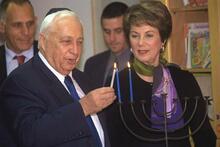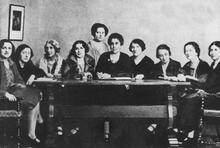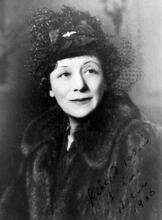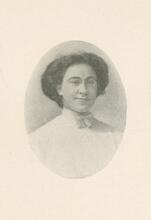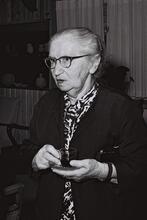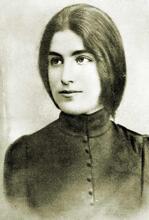Hannah Thon
Hannah (Helena) Thon was a social worker, journalist and editor, a student of Israel’s ethnic communities, and one of the leading figures in the women’s voluntary social-welfare organizations during the Yishuv (pre-State) period in Israel. Born in Germany in 1886, Thon first connected to Judaism and Zionism at age 21. She devoted her time to learning about Zionism and engaging with Zionist organizations. Some of her most impactful work includes founding WIZO (Women’s International Zionist Organization), running the women’s magazine Ha-Ishah, and creating neighborhood centers to support women and families in Israel. Thon was also deeply engaged in social work and research. Her research on different communities in Israel became the basis for social-work studies in Israel.
Early Life
Hannah (Helena) Thon was a social worker, journalist and editor, a student of Israel’s ethnic communities, and one of the leading figures in the women’s voluntary social-welfare organizations during the Jewish community in Palestine prior to the establishment of the State of Israel. "Old Yishuv" refers to the Jewish community prior to 1882; "New Yishuv" to that following 1882.Yishuv (pre-State) period in Israel. Thon was born in Dresden, Germany, on January 22, 1886. Upon the death of her father Avraham Cohn, when she was eleven years old, the family moved to Berlin. In Dresden, and later in Berlin, she was raised in a Christian environment and attended public schools. In a letter that Thon wrote in November 1953 recounting her life story, she began as follows: “I don’t know exactly what it was that drove me (who was raised in the Christian circles that my parents moved in) to cling to Judaism and to nurture it. Still, I remember when I was a young girl at the start of second grade, the teacher assigning seats to the children on two-seater benches. But my new benchmate complained: ‘Now I have to spend the whole year next to a Jew.’” And Thon added: “If it was indeed that same young girl who made me aware, for the first time in my life, of the difference between myself and others, then I convey to her—over the decades that have passed since then—my thanks.”
Thon graduated high school in Berlin and wished to continue her studies, but the difficult financial situation in the home made it impossible. She took a job as a secretary and in her free time would go to lectures, primarily about the social sciences. In 1907, at the age of twenty-one, she traveled to London, where she spent a year. She stayed with Christian relatives and it was actually through them that she was first exposed to Judaism. As she writes: “It was certainly no coincidence that, while staying in London at the home of our Christian relatives, I picked up the only Jewish book in their home, Children of the Ghetto by Israel Zangwill. … From here, in a state of great excitement, I went straight to the Jewish quarter of Whitechapel [the setting of the novel], where I discovered for the first time in my life, East European Jews who in all their customs, body language, spoken language, dress, remained faithful to their Jewish origins, much more so than the people among whom I myself had grown up.”
Introduction to Judaism and Zionism
Following this belated encounter with Judaism, Thon set about redefining herself, her identity and her worldview as a woman and an individual in European society. The identification of herself as a Jewish woman sparked concern for this homeless people wandering through the Lit. (Greek) "dispersion." The Jewish community, and its areas of residence, outside Erez Israel.Diaspora and led inevitably to a nationalist and Zionist awakening (even before she knew what Zionism actually was). In her words: “Here [in London], the awareness took shape in me that Jews who are living in northern lands are not in their proper place. A different, gentler climate shaped their appearance, their customs, their way of thinking and their memories, which include images from the tales of the Bible. Since then, I have begun to dream of the return of the Jews to their land—a land in which they will no longer dwell as strangers in alien surroundings but will fulfill their uniqueness and realize their dreams in their own homeland.”
One year later, when Thon returned to Berlin and spoke of this notion of the return of the Jews to their homeland which had captivated her, all around her responded with a smile: “It seems that you’re a Zionist. For Zionism has found the answer to your question.” Thon found her way into Berlin’s Zionist circle, where she attended her first Zionist meeting, which she recalled with great emotion years later: “To this day, I can experience anew the sense of great joy that flooded me when I realized that the idea that had sprung up in my mind as an illusory youthful dream had already been fashioned by others into an entire systematic plan that was attracting thousands of Jews from different lands.”
From then on, Thon devoted most of her time to learning about Zionism. She took part in Zionist gatherings in Berlin, read Zionist periodicals, and studied the history, literature, and poetry of the Jewish people through the generations. When she was offered the job of sorting the Jewish newspapers every Sunday at the Zionist Office in Berlin, her joy and pride knew no bounds. She was later given more responsibility, especially when it was discovered that she had writing talent. Thon began disseminating the Zionist idea both in speeches (before the Jewish public in Germany) and in writing (her articles on various Zionist topics appeared in such publications as Die Welt and Jüdische Rundschau).
In late 1911 Thon was sent to represent Die Welt (the official organ of the World Zionist Organization) in New York, where she was also asked to found and edit a Zionist Jewish weekly. In 1913 Thon returned to Berlin to continue her Zionist and journalistic work, but she was soon invited to Palestine by Arthur Ruppin (1876–1943) to run the secretariat of the Palestine Office in Jaffa (established following the Eighth Zionist Congress in the Hague to serve as the first Zionist legation in Palestine, and directed by Ruppin). Thon accepted the invitation and came to Palestine, but she was forced to return to Germany several months later, with the outbreak of World War I, since she did not hold Ottoman citizenship.
During the war years Thon continued her work in various Zionist frameworks. Initially, she worked in Munich, where she accepted the task of editing the newspaper Jüdische Echo which was published there. In 1916 she was invited by Martin Buber to take part in running the monthly journal, Der Jude, of which he was founder and editor. Here too, she did not stay long, being asked to assist Victor Jacobson, chairman of the board of the Zionist Organization Executive, based at the time in Copenhagen (due to the war, the ZO was transferred from Germany to Denmark). At this post, she edited the bulletin of the Palestine Office there.
Founding of WIZO
Following the war, Thon moved from Denmark to London, where in 1920 she took part in the founding of World WIZO (Women’s International Zionist Organization), the women’s arm of the World Zionist Organization, whose primary goal was to render assistance to women and children in pre-State Palestine. At the time, WIZO was headed by its founders: Rebecca Sieff, Vera Weizmann, and Edith Eder. Thon was elected chairwoman of the German branch of the organization.
In 1921 Thon visited Palestine once again, this time as an emissary of World WIZO, to lay the foundations for the establishment of a WIZO chapter there. During this mission, she decided to settle in Palestine and make it her home. That year, she married Dr. Ya’akov Thon (b. Lvov, Galicia, 1880; d. Israel, 1950), among the founders and leaders of the national institutions in pre-State Palestine. Dr. Thon served as the deputy of Dr. Arthur Ruppin at the Palestine Office in Jaffa (later replacing him during the latter’s exile in Turkey); was a founder of the Constituent Assembly of Keneset Yisrael and president of its Va’ad Le’ummi; among the founders of the Jewish Agency in Jerusalem; and director of the Palestine Land Development Company until his death. One year earlier, Dr. Thon had lost his first wife Sarah, who had left him with three children: Theodor, Yehudit, and Raphael. Hannah Thon now became their mother and also had her own child with Thon (Nurit). Nevertheless, she continued to work untiringly at her public activities, which can be classified into four areas: (a) leadership of the Histadrut Nashim Ivriot (HWO–Hebrew Women’s Organization merged with WIZO in 1933); (b) editor of Ha-Ishah, the first women’s magazine in Palestine; (c) assistance and counseling in the poor Jewish neighborhoods of Old and New Jerusalem; (d) teaching and research in the field of social work.
Work With WIZO
As mentioned above, Thon came to Palestine as an emissary of World WIZO and began to put in motion plans to set up a girls’ school for training in farming and home economics; a kitchen for new-immigrant women; a hostel for young women, and so on. After becoming familiar with the local welfare situation, in particularly the primitive living conditions of the weaker population groups, she came to the conclusion that Palestine needed its own women’s organization, and not a branch of a world body. This led to tensions between her and the leadership of World WIZO, and she turned for advice to Henrietta Szold, with whom Thon had developed a friendship during her time in New York (1912). Szold (1860–1945), who immigrated to Palestine at the age of sixty, lived in Jerusalem and served as chairwoman of the Histadrut Nashim Ivriot. Like Thon, Szold felt that there should be a separation between the activities of Jewish women’s organizations in the world at large and those in Palestine due to the latter’s unique needs, as evidenced by the fact that Hadassah–Women’s Zionist Organization, which Szold founded and headed (United States, 1912), did not operate any branch in Palestine, instead offering its aid and support for vital projects. Szold proposed to Thon that she join the HWO, which Thon did; apparently, local activity in Palestine was so essential in her eyes that she left WIZO and became one of the leading figures in the HWO.
Already in 1923, Thon was elected (along with Henrietta Szold and Leah Berlin) to the Executive Committee of the HWO, a type of presidium of the organization’s Central Council. She served as chairwoman of the national HWO from 1927 to 1928. In the elections for the Va’ad Leummi in 1930, when the HWO ran on a joint slate with the Union of Hebrew Women for Equal Rights in The Land of IsraelErez Israel, Thon was granted the third slot on the list (following Henrietta Szold and Dr. Helena Kagan).
From the outset, it was HWO’s policy to work jointly with the other women’s voluntary organizations. Since the General Council of Women Workers (Mo’ezet ha-Po’alot) rejected any such cooperation (in their struggle to implement proletarian values, they saw the HWO as an obstructive, bourgeois candidate), HWO’s initiative was directed towards other organizations, in particular WIZO. Thon played an important role in promoting this collaboration. As the HWO’s representative for foreign relations, she appeared at conferences of World WIZO in Europe, where she reported on the basic problems characteristic of the social and cultural conditions of women in pre-State Palestine (particularly those from the non-labor and ethnic sectors of the Old Yishuv, who were being ignored while the focus was placed on pioneer women who had come to Palestine to fulfill themselves as agricultural workers). Between 1923 and 1929 all attempts at unification met with failure and it was only at the WIZO conference in Zurich in 1929 that a path toward understanding began to emerge. In a speech delivered by Thon at the close of the conference, she referred to it as a “historic occasion.” But another four years of mutual confrontation were to pass before the union was finally effected and a joint council was established in 1933 under the new name of the Zionist Women’s Organization (replacing the Hebrew Women’s Organization).
Ha-Ishah
Another groundbreaking project organized and run by Hannah Thon as part of the HWO was a women’s magazine, the monthly (sometimes bi-monthly) Ha-Ishah, which was published in Jerusalem for three years (1926–1929). Thon not only edited the magazine but shaped its image as a publication dealing with women’s affairs, society, and culture. Emma Esther Smoira (1889–1951), who recounts the history of the HWO in her book Hebrew Zionist Women, states that the magazine was founded with the aim of conveying to a broader public the goals of the HWO, namely, building a liberal, civic society in Palestine and educating a new woman in this spirit. In Palestine at the time, the image of women reflected two opposite extremes: on the one hand, the traditional woman, housewife and mother, who was inferior to her husband, with minimal rights and very often without any education at all; and on the other hand, the liberated socialist pioneer woman who rejected the traditional patriarchal bond, demanding masculine activities and tasks as the way to achieve equal rights and equal status.
In her first piece in the magazine, “Women in the Public Domain in Palestine,” Thon proposed a third model of woman that conformed to the worldview of the HWO: philanthropic civic involvement coupled with efforts to improve the status of women. As Thon writes: “Between these two extremes [traditional and socialist] are those women who stand out for their wide-ranging national liberalism. These ‘women in the middle’ recognize the family as the natural unit of the state and support the basic role of women as caring for the home and children. But in recognition and understanding of the overall goal of building the nation, this simple duty of women is elevated by them to a much loftier level than that of an ordinary housewife.” In other words, Thon is speaking of a liberal national model of a Palestinian Jewish woman who, in her life, synthesizes the public and the private domains: running the home together with involvement in the life of the community; the experience of motherhood alongside acquiring an education and professional training; obligation to the family unit but also self-fulfillment and an awareness of her equal rights and her role in the emerging society.
This approach also dictated the format of the magazine, its sections and its subject matter. As a women’s magazine, the articles were devoted first and foremost to topics concerned with home and family such as home economics and the running of a home; infant care; education of children; relations with one’s spouse; and of course, women’s health and the maintaining of hygienic and esthetic standards. But alongside this practical information, the magazine also addressed such fundamental gender issues as “what is femininity” in essence and from a cultural standpoint; and, needless to say, preoccupied itself with the social problems of certain groups of women whom the New Yishuv, somewhat surprisingly, took no interest in and even looked down upon (e.g., ultra-Orthodox, Sephardic and Arab women). Discussion of these problems, out of this same sense of civic, liberal and/or feminist involvement, created other frames of reference for issues relating to women and their oppression (such as marriage of minor girls, domestic violence, women’s illiteracy, exploitation of women workers and the like) and did much to raise awareness in the Yishuv with respect to these neglected social issues.
Nevertheless, it seems that the broad canvas of the monthly and its diverse subject matter were greeted with criticism by women readers. In particular, they were displeased with the publication of literary material written by women authors, arguing that their works could be read in other magazines. Thus, after seven issues the sections on intellectual topics ceased to appear and discussion centered strictly around practical matters. Special issues were also devoted to a specific problem such as Welfare Services for Children and Young People (1928). Disagreements over the editing of the monthly ultimately led to Thon’s resignation. While a succession of other editors tried to stir up interest, their efforts met with failure. In July 1929 the last issue appeared, so that in all, nineteen issues of the magazine were published.
Development of Neighborhood Centers
The HWO was founded as a voluntary organization with the stated aim of trying to remedy social problems in the Yishuv community. Jerusalem was the first locale where the organization began operating and from the outset it was clear that there was a need for guidance and assistance for pregnant women and mothers of young children in impoverished neighborhoods. With the years, the needs grew, in particular during the period of the Great Depression with the rise in new immigrants and a local population that was already needy. During this period, centers were also opened in Haifa, Tel Aviv and Tiberias, providing aid in the form of soup kitchens, Tipat Halav (mother and child care clinics), distribution of clothing, adult education, legal aid, and day care for the children of working mothers. Underlying all of these was the social policy of HWO, which Thon, with her education and experience in this field, helped formulate. The most successful social experiment during this period was the “neighborhood center,” initiated and developed by her. Thon had encountered such centers in the slums of London and New York, where the “Toynbee program” of settlement houses was being put into practice (after Arnold Toynbee [1852–1883], the British economist and social scientist who conceived these educational and social centers).
Thon decided to implement this program in Jerusalem’s most impoverished neighborhoods—Shimon ha-Zadik and Nahalat Ahim. The vast majority of the heads of families in the Shimon ha-Zadik quarter were unemployed, resulting in unbearable economic hardship. Thon appealed to the women, asking them to become the breadwinners and, in so doing, to raise their self-esteem as independent women contributing to the family’s livelihood. She rented a two-room flat, turning one room into a workshop for the manufacture of rugs from scraps of material where women (altogether sixty) worked at one time or another, and the other room into a daycare center for their children. The women took part in the work, but were not overly enthusiastic. It later became clear that these women excelled in their own traditional style of embroidery and when it was proposed that they turn this colorful embroidery into a marketable product, they produced wonderful work that sold well.
These minimal economic successes encouraged Thon and her staff to continue developing the neighborhood in other areas. A Tipat Halav clinic was set up, vegetarian meals were distributed for a nominal fee and Hebrew classes for women were offered. But Thon did not content herself with these achievements; her aim was not only to set up institutions but also to teach local residents how to make proper use of these institutions and steer them towards independent activities and initiatives of their own. Trained women workers and volunteers worked with families individually, in this way making the neighborhood center in Shimon ha-Zaddik the first of its kind in the country and a progressive model of social welfare for other cities. (Thon set up and managed a similar center in the Nahalat Ahim quarter.) The neighborhood centers also served as a refuge for children who were not in any school framework; instead of letting the children wander the streets, they were taken in by the center, fed and kept occupied with games and basic instruction.
Social Work and Research
The early 1940s saw the establishment of the first school for the training of social workers in Palestine (later called the School of Social Service [1948]), which was founded and directed by Siddy Wronsky. At first, no suitable building could be found; as a result, classes took place in various apartments, among them the home of Hannah Thon, who taught at the school. When the school later found a permanent home on Abarbanel Street in the Rehaviah neighborhood of Jerusalem, Thon put together a program of social work courses that she taught in Haifa as well.
Over the years Thon had amassed a great deal of material and in 1947 she also began conducting surveys on Sephardic Jews from the Balkans, North Africa, Yemen and Asia. Three hundred families from various ethnic communities in Jerusalem, covering a range of three generations, participated in these comprehensive studies (carried out under the auspices of the Social Welfare Department of the Va’ad Le’ummi and the Jewish Agency’s Institute for Economic Research). Much of this study and its conclusions were published by the Henrietta Szold Institute in 1948 under the title Thirty Western [Moghrabi, i.e., from northwest Africa, including Morocco, Tunisia and Algeria] Families in the Old City of Jerusalem.
Thon studied these groups not only through her daily contacts with them, but by means of ongoing surveys and follow-up in the field. According to Miriam Itzkowitz, director of the School of Social Service, Thon sought to expand and deepen the insight into these groups through historical research as well, exploring their past, their experiences and their lifestyle in their countries of origin. It should be noted that this book was written in its final form during the last year of Thon’s life, when she was greatly weakened as a result of progressive muscular degeneration. Nevertheless, Thon did not give up, granting herself one sole concession: to write the book in German, her mother tongue. After her death, the book was read by such renowned researchers as Professor Shlomo Dov Goitein and Professor Abraham Boneh, as well as Izhak Ben-Zvi, a student of ethnic communities and later president of Israel. They and others unanimously approved the manuscript and its translation into Hebrew.
Legacy
In 1957, three years after her death, Thon’s research was published as a book, entitled Ethnic Communities in Israel: Aspects of Their History and Areas of Settlement in Palestine. Adapted from Thon’s lectures, it became the basis for social-work studies in Israel. Not without reason did the School of Social Service make every effort to have this important work updated and revised so that it might serve as learning material for students and others (including social workers, school and kindergarten teachers, youth-group leaders and nurses). In the preface to the book, whose introduction was written by Miriam Itzkowitz, Thon is described as a pioneer in the study of the sociology of Sephardic Jewry in Palestine. The book consists of three chapters: the first, dealing with the Descendants of the Jews who lived in Spain and Portugal before the explusion of 1492; primarily Jews of N. Africa, Italy, the Middle East and the Balkans.Sephardim of the Old Yishuv and with the new Lit. "ascent." A "calling up" to the Torah during its reading in the synagogue.aliyah from the Balkan countries; the second, with the waves of aliyah from North Africa both before and after the establishment of the state; and the third, with the Jews of Yemen and the Asian countries. According to Itzkowitz, not only did Thon accompany the new-immigrant families from these lands “through their difficulties in striking roots in Palestine and their cultural struggles”; she also “kept track of them for years, in their search for new patterns in their economic and social lives.”
An additional area of activity that deserves mention was Thon’s involvement in the Organization of German Immigrants and the political party known as Aliyah Hadashah—Association of Central European Immigrants (she sat on the Jerusalem branch executive.) Through these bodies, Thon assisted in the absorption of immigrants from Germany, in particular those refugees who had fled empty-handed with the ascent of the Nazi regime. Thon made frequent appearances before such groups, explaining and advising about life in Palestine. Her daughter recounts how, during the mass aliyah from Germany (1933), there was a gathering at her home every Sabbath to welcome newly arrived female/sing.; individual(s) who immigrates to Israel, i.e., "makes aliyah."olim (immigrants). During her journey to the Nineteenth Zionist Congress in Lucerne, Switzerland (1935), Thon took the opportunity to continue on to Germany and appear before the Jews there with the aim of encouraging them to emigrate to Palestine before it was too late.
Thon died in Jerusalem on March 10, 1954.
Selected Works
Hebrew
Thon, Hannah (Helena). “The Last Article” (November 6, 1953).
M.B. (Mitteilungs Blat) Yedi’ot: Irgun Olei Merkaz Europah 15 (April 1954).
“Thirty Western Families in the Old City of Jerusalem.” In Le-ma’an ha-yeled ve-ha-no’ar. Jerusalem: 1948.
Ethnic Communities in Israel: Aspects of Their History and Areas of Settlement in Palestine, with an introduction by Miriam Itzkowitz, 7–8. Jerusalem: 1957.
Hebrew
Doron, Avraham. “Individual Welfare Services in Israel: Changes in Leadership and their Ramifications in Shaping the System.” Bit’on Soziali 65 (2004): 11–32.
Keren, Michael. “Ha-Ishah and Civic Society in the 1920s.” Kesher 28 (November 2000): 28–35.
Smoira, Esther. Hebrew Zionist Women: The Story of the Hebrew Women’s Organization from its Founding (written in 1951). Tel Aviv: 2002.
Tidhar, David, ed. “Hanna (Helena) Thon.” Enziklopediah le-Haluzei ha-Yishuv ve-Bonav, vol. III, 1369. Tel Aviv: 1949.
Ziv (Thon), Nurit. “Dr. Ya’akov Thon.” M.B., Yedi’ot: Irgun Olei Merkaz Europah 154 (May 2000).
My deepest gratitude to Nurit Ziv for her tremendous assistance by providing documents and information about her mother.

